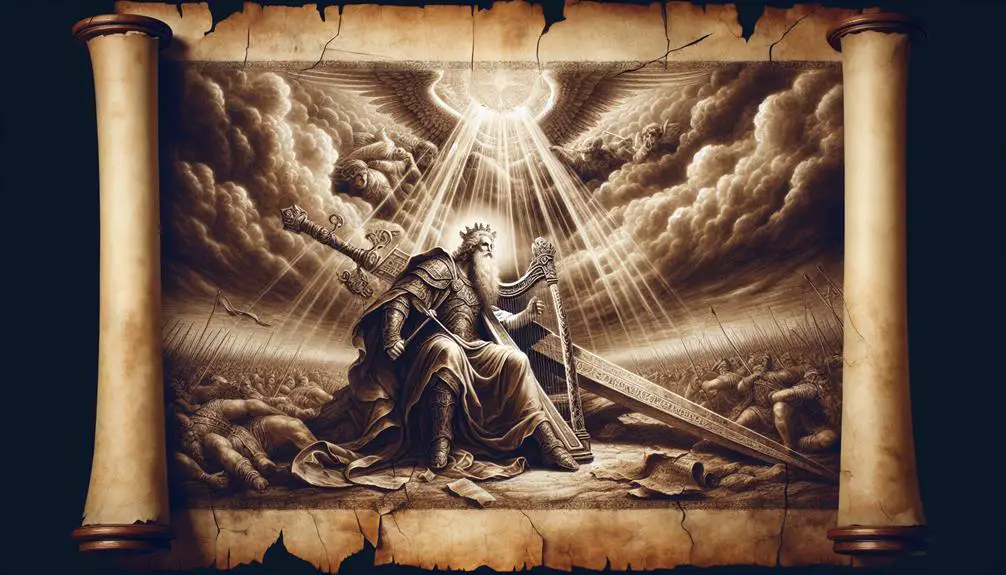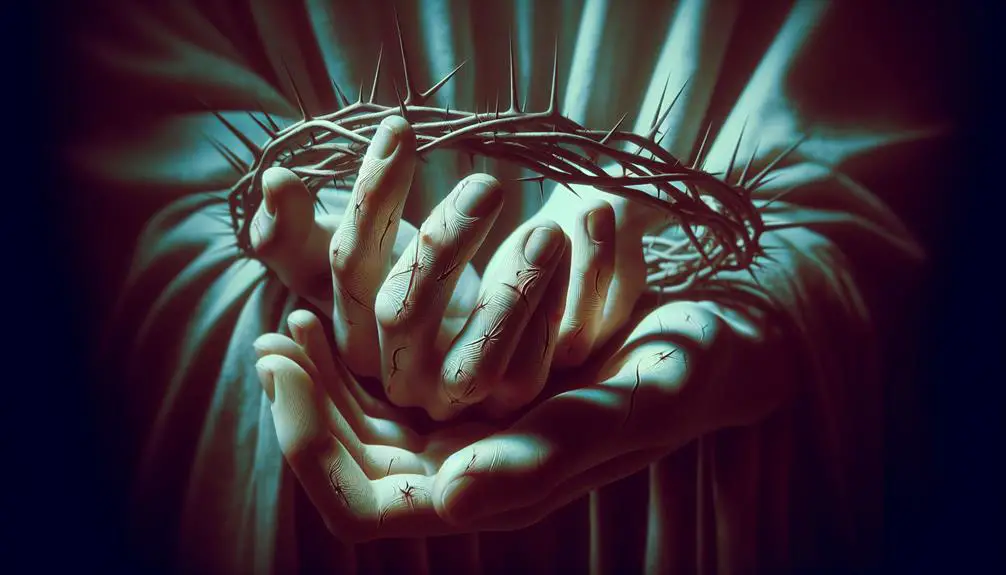Wounds and scars in the Bible reveal profound lessons on suffering, redemption, and divine purpose, inviting deeper exploration into their spiritual significance.

Scars in the Bible
In exploring the narrative of scars within the biblical context, one embarks on a journey through profound symbols of suffering, redemption, and divine purpose. From the enigmatic mark of Cain to the poignant wounds of Christ, these scars serve not merely as physical manifestations but as profound metaphysical markers that transcend their immediate context.
Each story, whether it be Jacob wrestling at Peniel, Job's unparalleled suffering, or David's enduring trials, encapsulates a unique dialogue between human frailty and divine sovereignty. Engaging with these narratives invites a deeper contemplation on the significance of scars in both a historical and spiritual framework, beckoning a further exploration into their enduring legacy within the tapestry of faith.
Key Takeaways
- Scars symbolize divine intervention, protection, and the consequences of human actions.
- They mark significant transformations and the emergence of new identities.
- Scars are testimonies of resilience, healing, and redemption in the face of suffering.
- They serve as reminders of moral lessons and pathways to deeper understanding and grace.
The Mark of Cain

In the context of biblical narratives, the Mark of Cain represents a complex symbol of protection, punishment, and divine intervention. This mark, bestowed upon Cain after he commits the first murder by killing his brother Abel, serves as a multifaceted emblem within religious texts. It simultaneously signifies Cain's legacy as the original perpetrator of homicide and an object of divine punishment and mercy. The narrative, deeply embedded within Judeo-Christian theology, offers a rich ground for theological and moral interpretations concerning sin, justice, and God's sovereignty.
The mark's primary purpose, as outlined in the scriptures, is to protect Cain from vengeance, ensuring that his punishment is solely God's prerogative. This aspect highlights a divine principle that transcends human notions of retribution, introducing a complex interplay between justice and mercy. Cain's legacy, therefore, is not only marked by his sin but also by the divine protection he receives, underscoring the nuanced nature of divine punishment and forgiveness.
Furthermore, the Mark of Cain serves as a perpetual reminder of the consequences of sin, both to Cain and to the broader human community. It embodies the tension between divine justice and mercy, illustrating that while sin necessitates punishment, divine intervention can also offer protection and a path towards redemption. This dual symbol, deeply ingrained in biblical lore, continues to evoke contemplation on the themes of guilt, retribution, and divine grace, making Cain's story a cornerstone for discussions on the nature of sin and forgiveness within the Judeo-Christian tradition.
Jacob Wrestles at Peniel

Exploring another profound narrative, the story of Jacob wrestling at Peniel offers invaluable insights into themes of transformation, identity, and divine encounter within the biblical tradition. This episode is not merely a physical struggle but a pivotal moment in Jacob's life, marking a significant identity transformation through a divine encounter. This narrative serves as a metaphor for the struggles that can lead to profound changes in one's life and relationship with the divine.
- *Jacob's struggle at Peniel is a night-long wrestle with a mysterious figure, traditionally understood to be an angel or God Himself, highlighting the intensity and ambiguity of divine encounters.*
- *The physical outcome of this encounter—a permanent limp—serves as a tangible symbol of Jacob's transformation and the enduring impact of his struggle with the divine.*
- *Jacob's name change to Israel, meaning 'he struggles with God,' signifies not only his personal transformation but also the birth of a new identity that would become foundational for an entire nation.*
- *This narrative underscores the theme that encounters with the divine, though they may leave scars, are transformative, leading to a deeper understanding of one's identity and purpose.*
Analytically, the story of Jacob at Peniel embodies the complexities of human-divine interaction, where physical struggle mirrors spiritual and existential wrestling. It suggests that true transformation often comes through hardship and confrontation with the transcendent. The permanence of Jacob's injury serves as a reminder that encounters with the divine, though they may wound, are also sources of blessing and profound identity transformation. This narrative invites reflection on the nature of divine encounters and their capacity to reshape individuals in enduring ways.
Job's Suffering and Restoration

The narrative of Job's suffering and subsequent restoration presents a compelling exploration of resilience, faith, and divine justice within the tapestry of biblical literature. This story, deeply embedded in the Judeo-Christian tradition, meticulously details the trials of Job, a man renowned for his unwavering righteousness and prosperity, who faces an onslaught of catastrophic losses and physical afflictions. These adversities, permitted by God as a test of faith following Satan's challenge, culminate in a profound display of patience exemplified by Job amidst unparalleled suffering.
Analytically, Job's ordeal and the dialogue it incites between him and his friends, and ultimately with God, serves as a rich soil for theological inquiry into the nature of divine justice and the human condition. The narrative does not shy away from portraying the raw and often unsettling questions that arise from human suffering and divine sovereignty. Job's relentless quest for understanding and his refusal to curse God despite his friends' urging highlight a nuanced portrayal of faith that is both questioning and steadfast.
The restoration of Job's fortunes, health, and family at the narrative's conclusion, while not erasing the scars of his trials, offers a powerful testament to the concept of divine justice that transcends human understanding. It asserts that faithfulness amidst suffering is recognized and rewarded by God, albeit in ways that may defy human expectations.
Through the lens of Job's story, the biblical text invites readers to grapple with the complexities of faith, suffering, and divine justice, portraying patience and perseverance as virtues that hold divine significance. This narrative remains a timeless reflection on the human condition, challenging believers and scholars alike to contemplate the profound mysteries of faith and divine providence.
David's Trials and Triumphs

David's life, marked by a series of profound trials and remarkable triumphs, offers an intricate study of leadership, faith, and the complexities of human nature within biblical narratives. His journey from a shepherd boy to the king of Israel encapsulates a life filled with divine appointments, human frailties, and the redemptive power of faith in the face of formidable challenges.
- *The Goliath battle*: This event is not merely a tale of physical conquest but symbolizes the victory of faith and divine providence over insurmountable odds. David's unwavering faith in God, armed with only a sling and a stone, led to the defeat of the Philistine giant, illustrating the triumph of spiritual strength over physical might.
- *Saul's jealousy*: This theme underscores the psychological and moral complexities within David's narrative. Saul's envy towards David, following his victory over Goliath and increasing popularity, sets the stage for a tumultuous period in David's life, highlighting the destructive nature of jealousy and the resilience required to navigate through personal betrayals and conflicts.
- *David's ascent to kingship*: Despite the obstacles, including Saul's attempts on his life, David's journey to becoming king exemplifies patience, strategic wisdom, and an unwavering commitment to God's timing, offering profound insights into divine sovereignty and human agency.
- *Moral and ethical dilemmas*: David's life was also marked by personal failures and sins, notably his affair with Bathsheba and the ensuing consequences. These episodes provide a complex examination of repentance, forgiveness, and the enduring scars of sin, emphasizing the importance of accountability and redemption in leadership.
David's narrative, enriched with trials and triumphs, invites a contemplative exploration of the scars that shape us, the grace that sustains us, and the providence that guides our destinies within the tapestry of human and divine interaction.
The Wounds of Christ

Shifting focus to the New Testament, the wounds of Christ represent a profound embodiment of sacrifice, redemption, and the fulfillment of prophecy within Christian theology. These wounds, received during Jesus' crucifixion, have been a focal point for reflection, inspiring faith and devotion across centuries. Theologically, they signify not only Jesus' suffering and death but also his victory over sin and death, marking a pivotal moment in the salvation narrative.
The wounds of Christ, particularly post-Resurrection, serve as a critical proof of his physical resurrection and identity. This is vividly illustrated in the encounter with Doubting Thomas, wherein Thomas' doubt is transformed into belief upon witnessing and touching Jesus' wounds. This episode underscores the tangible reality of the Resurrection, bridging the physical and the spiritual, and affirming the continuity of Jesus' identity before and after his death.
Moreover, the wounds of Christ have been interpreted as a testament to the depth of God's love for humanity, signifying a divine willingness to suffer for the sake of human redemption. They also fulfill Old Testament prophecies, such as those found in Isaiah, which spoke of a suffering servant who would bear the sins of many.
Frequently Asked Questions
How Do Biblical Teachings Interpret the Spiritual Significance of Physical Scars Outside of the Well-Known Stories?
Biblical teachings often imbue physical scars with profound spiritual significance, viewing them as emblematic of trials overcome and lessons learned. These 'Redemption Marks' are interpreted as tangible evidence of personal transformation and divine intervention.
The concept of 'Scarred Leadership' further illustrates how such marks are not merely remnants of past afflictions but also symbols of resilience, wisdom, and authority gained through experience, guiding others through their spiritual journeys and challenges.
In What Ways Do Scars Symbolize Covenant or Promises in the Bible, Beyond the Explicit Marks Mentioned in the Key Narratives?
Interestingly, while not explicitly detailed within the core narratives, scars symbolize covenant representation in profound yet understated ways. This scar symbolism extends beyond physical marks to embody spiritual promises and commitments.
Analytically, these representations serve as tangible reminders of intangible agreements, echoing the depth of divine-human relationships. The nuanced interpretation highlights how scars, often perceived as marks of pain, can also signify enduring bonds and sacred pledges within a broader spiritual context.
Are There Any Lesser-Known Biblical Characters Whose Scars Tell a Significant Story Not Covered in the Major Sections?
Exploring the narratives of lesser-known biblical figures reveals profound insights into themes of struggle and redemption.
Jacob's struggle, resulting in a lasting physical impairment, serves as a powerful metaphor for transformation and divine encounter.
Similarly, Mephibosheth's lameness, a consequence of an accident, underscores themes of grace and restoration within the context of royal favor and covenantal loyalty.
These stories, while not prominently featured, offer significant depth to the understanding of personal trials and divine faithfulness.
How Does the Bible Address the Healing Process of Scars, Both Physically and Emotionally, Outside the Context of the Highlighted Stories?
The Bible employs scar metaphors and healing prayers to address the recovery process from physical and emotional wounds. This scripture offers a comprehensive perspective on healing, transcending specific narratives to provide a broader spiritual context.
It suggests a pathway to restoration that encompasses prayer, faith, and community support. These elements collectively highlight the importance of seeking divine assistance and communal empathy in overcoming the scars of life's adversities.
Can Scars From Non-Physical Sources, Such as Emotional or Spiritual Scars, Be Found in Biblical Teachings, and How Are They Discussed or Treated?
In exploring the concept of non-physical scars, such as those stemming from emotional or spiritual distress, biblical teachings offer profound insights. These scriptures emphasize the path to healing through forgiveness and cultivating emotional resilience.
Analytically, these texts suggest that healing emotional and spiritual scars requires an introspective journey, underpinned by faith and forgiveness, which facilitates personal growth and resilience.
This approach underscores the holistic view of healing, aligning physical, emotional, and spiritual well-being.
Conclusion
In conclusion, the examination of scars within the biblical narrative reveals a complex interplay of divine intervention, human struggle, and ultimate redemption.
These marks, whether physical or metaphorical, serve not only as reminders of past tribulations but also as symbols of resilience and grace.
Through the stories of Cain, Jacob, Job, David, and Christ, the Bible articulates a profound theology of suffering that underscores the potential for transformation and renewal inherent in the human experience of pain and recovery.



Sign up